The $1000 mark is a historical delineator in the world of guitars. Typically, models priced above this point are squarely aimed at professionals and working musicians, not only in terms of cost, but features and build quality, too.
However, it is possible to get your hands on some incredible hidden gems under the $1000 mark, that offer similar, if not equal or better performance and quality. That’s why in this KillerGuitarRigs Review we’ve completed a round up of the 7 best electric guitars under $1000.
When we reviewed these models, we were of course looking for playability, tone, quality, and ultimately what kind of value they represented. If you’re working with a max budget of $1000, and you’re looking to see just what you can get for your money (with change to spare in some cases), you’re definitely going to want to keep on reading.
Read more about our review process.
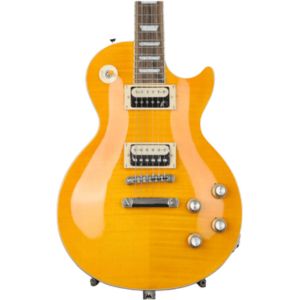
Epiphone Slash Les Paul Standard
Features: Flamed maple cap, CTS Electronics, Custom ProBucker pickups
Benefits: Authentic Slash tones, Incredible aesthetics, High end playability
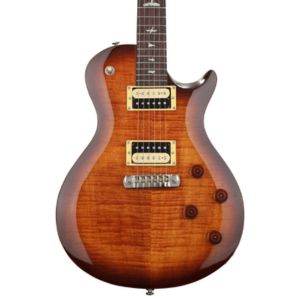
PRS SE Standard 24
Features: Coil splitting, Tremolo bridge, Rosewood fretboard
Benefits: Fantastic feel, Great tuning stability, Exceptional playability
Contents
Our Top 3
The PRS SE Standard was our top pick. This PRS is attainably priced and delivers big on all of the areas that have made guitars from this brand some of the most sought after in the world. Playability is superb, and the quality for outweighs the price tag.
For cost conscious players looking to get a great guitar and still have some cash left over for a nice amp and some accessories, we’d suggest our best budget pick, the Squier 40th Anniversary Gold Edition Telecaster. This Tele looks fantastic, and offers similar feel and features to some pricier models.
Those looking for the best guitar under $1000 should take a good look at our Editor’s Choice, the Epiphone Les Paul Slash Standard. With this LP you’re getting the Gibson experience for a much lower cost. It offers huge vintage PAF tones, and it looks outstanding.
Individual Reviews
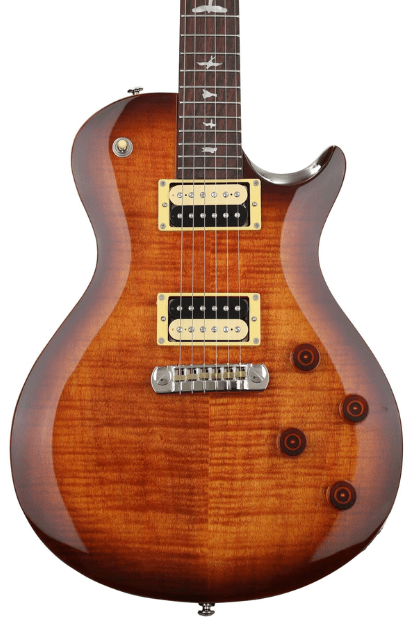
PRS SE Standard 245
Superb ergonomics, fat tones, and fantastic build quality.
Players looking for a handsome single cut guitar with thick sounding humbuckers, and easy playability can’t go wrong with this PRS. It has all the trademark features of the brand, including quality hardware, beautiful wood selection, and excellent electronics.
The PRS SE Standard 245 is an often overlooked model, but we think in the sub $1000 category it’s definitely worth consideration.
It had a simple, but beautifully crafted mahogany body. Our test model came in a Tobacco Sunburst finish, which was little plain, but it did show off the fantastic natural grain of the wood. One of the things we loved most about the body were the cutaways and the low profile heel – they really improved playability and made it an incredibly comfortable guitar to play.
The neck, like the body, was also made with mahogany. It was pretty beefy, and had the PRS Wide Fat Carve. It reminded us a lot of the neck on the Slash Signature, but was perhaps a little thicker. Fans of thin necks probably won’t enjoy this guitar, but if you like a vintage feel, this neck is fantastic.
As for electronics, the SE Standard 245 came fitted with PRS 245 S humbuckers. They were a matched pair, and for the most part, we liked them a lot. They delivered quiet, glassy clean tones, especially in the bridge. The neck gave us thick, warm tones that were perfect for blues.
We found that the finish quality was excellent, as was tuning stability. The choice of hardware worked really well with this guitar, especially the hardtail bridge, which contributed in a big way to this guitar’s reliability. The tuning machines were PRS branded, and just as we expected from past experience with PRS SE models, they performed perfectly – in fact we wish these were the machines that PRS had installed on the SE Silver Sky.
Verdict: We really enjoyed playing the PRS SE Standard 245. We loved that it wasn’t pretentious or too “try hard”, it was a simple, quality guitar, that delivered robust tones, and looked fantastic. On top of the great looks and performance, it also happened to come with a really nice backpack style padded gig bag, which on its own would cost $100!
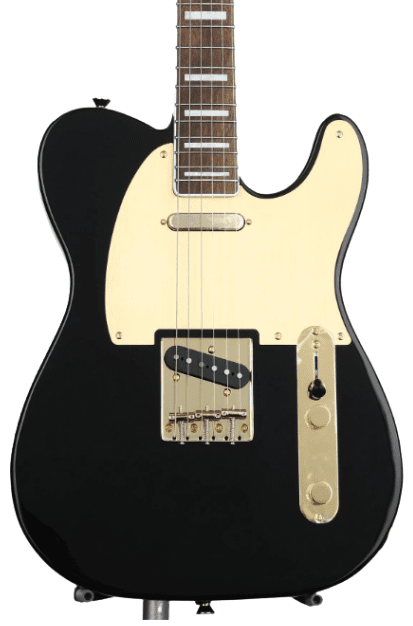
Squier 40th Anniversary Gold Edition Telecaster
One of the very best guitars ever made by Squier.
This guitar is easily one of the best looking Squier models ever made. It’s fitted with quality hardware, upgraded electronics, and thoughtful touches that make it stand out from other Squier models. It represents incredible value for money, and is definitely worthy of your consideration if you’re looking for Telecaster twang under $1000.
The Squier 40th Anniversary Gold Edition Telecaster is one of the latest guitars in the Squier lineup, and it’s already making waves as one of the best. It’s based on the ever popular Classic Vibe models, but adds upgraded hardware and improved aesthetics.
The body was made from nyatoh, which is admittedly an unusual wood choice for a Telecaster. You might know nyatoh by its other name, nato, and you might also know it as an affordable alternative to mahogany. It did make it a little heavier than the average Tele, but not so much that it was uncomfortable. Our test guitar came to us in Black, which looked sensational with the gold anodized pickguard and gold hardware.
It had a modern C shape maple neck, which felt much more comfortable than the typical Squier vintage C neck. Even though it had vintage styling, the 9.5” radius gave it super modern playability. The laurel fretboard was genuinely very nice, something we don’t often say at KGR! We particularly liked the pearloid block inlay, which really made this look like a special model.
For pickups, it had the standard Telecaster setup, with single coils in the bridge and neck positions and a 3 way selector switch. Unlike cheaper Squiers, these were custom Fender designed alnico pickups, that delivered big, punchy tones, with everything from bell like cleans, to throaty rock and roll sounds, and of course, the classic country twang.
The hardware looked great in gold. It really stands out from the average Telecaster; Squier has done an excellent job of making this model feel special. It came equipped with the 3 saddle bridge found on vintage Teles, and some of today’s high end Fender versions. It offered us fantastic sustain and responsiveness, and it really finished off the look.
Verdict: The Squier 40th Anniversary Gold Edition Telecaster is an outstanding way to get your hands on a great Telecaster guitar and still have plenty of change from your $1000 budget. As far as playability and tones are concerned, it’s a genuine competitor against entry level Fender models, and we think it looks even better!

Epiphone Les Paul Slash Standard
A pro quality Les Paul with a premium finish and exceptional performance.
With this Les Paul you’re getting a great opportunity to own a Slash Signature model at a fraction of the price of the original Gibson model. It looks simply stunning, and arguably better than Gibsons at a similar price point. A must for any die hard GNR fan.
The Epiphone Slash Les Paul Standard is one of their heralded signature models, and because it’s an import, you’re getting a professional level guitar for upper intermediate money.
The body was made in the classic Les Paul tradition – a solid mahogany body, topped with a beautiful AAA grade flamed maple cap. The test model we played was finished in November burst, which is of course, named for the finish on the guitar Slash used in the iconic November Rain video. It looked incredible, and might just be the best looking guitar in the entire Epiphone lineup.
We absolutely loved the neck on this Les Paul; it had the Slash Custom C profile, which was substantially thicker than the SlimTaper D found on most of the Epiphone Les Pauls. It’s carved to the specs of Slash’s own guitar, and it’s easy to see why he chooses this profile. Despite the girth it offered superb playability, and the finish made it feel like our hands were gliding over it.
Topping off the fretboard was an Indian laurel fingerboard. It was clearly a more choice cut than you’d find on the lower level models, as it was noticeably better hydrated and had a far tighter grain than we’d found on other Epiphones with laurel boards. We found that the fretwork was superb, too, with perfect edges and well polished crowns.
It was fitted with Custom ProBuckers, with this set being found only on the Slash Signature model. True to those used by Slash himself, they’re based on the classic PAF models found on early Gibson Les Pauls, and they gave us everything from crispy cleans to screaming high gain tones – they were dynamic, and super responsive in all conditions.
Verdict: This Epiphone Les Paul Slash Standard can be polarizing, some would say they might not pay Gibson money for an Epiphone, but we’d advise you to look past pre conceived notions and look at this for what it is – a high end Les Paul that just happens to be made somewhere other than the US. It uses the same electronics as a US made model, and other than for the headstock, you’d likely never be able to tell it wasn’t a Gibson.
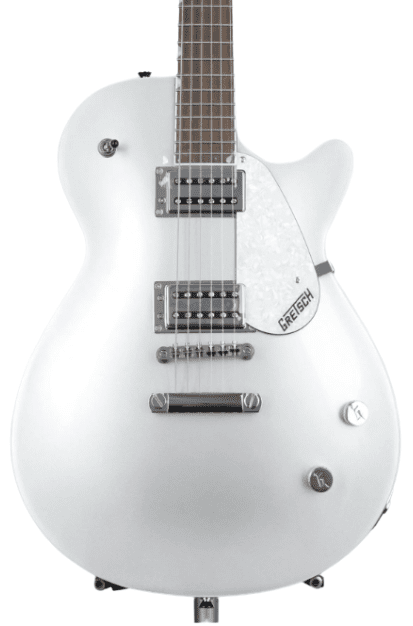
Gretsch G5426 Jet Club
Fantastic retro styling and excellent all round performance.
Gretsch guitars are well known for their cool vintage aesthetics, and this model is no different. This single cut solid body offers light weight comfort without sacrificing tone or sustain. It has a dynamic tonal palate, and brings with it the classic ‘50s Gretsch sound that many try to replicate.
The Gretsch G5426 Jet Club is one of those guitars that everybody loves. Despite being one of their more affordable guitars, it still checks all the boxes for must have Gretsch features.
Thanks to the chambered basswood body, the weight was kept to a minimum, making it super comfortable to play for extended periods of time. The body did have a maple cap, too, which was there to add some additional brightness and balance out the tone. Our test guitar was finished in Silver, which was a really subtle color that we thought suited the Jet Club well.
It had a comfortable maple neck, which was a lot thinner than most vintage style guitars. We found it to be very comfortable, and the finish on the back was slick. We don’t often think of Gretsch Electromatics as shredders, but it definitely had some speed. It had a 12” radius, which struck a nice balance for those who want to play both rhythm and lead.
We loved the rosewood fretboard, which is as we’ve pointed out, quite rare these days, even on much more expensive models. It looked fantastic, and felt superb. The offset fret markers made it stand out even more, too.
The fretwork was impressive, and further added to the comfort of the Jet Club. The edges were well profiled, and the tangs were nicely hidden behind the fretboard binding.
Tonally, the Jet Club was surprisingly diverse, largely thanks to the Gretsch humbuckers. With the volume cranked and the bridge pup selected, it came alive with high output rock and roll crunch. With the volume and tone rolled back just a touch and the neck position selected, it delivered warm, soothing jazz tones, and we had a great time exploring all of the tones in between.
The chrome tuners worked well, tuning stability was great, and thanks to the tune-o-matic bridge, we found that intonation was excellent.
Verdict: We had tons of fun with the Gretsch G5426 Jet Club. It was one of the most comfortable guitars in the bunch, and gave us a huge rage of tones to play with. The neck felt great, and it was easy to see how much work had gone into the fit and finish, which was close to perfect.
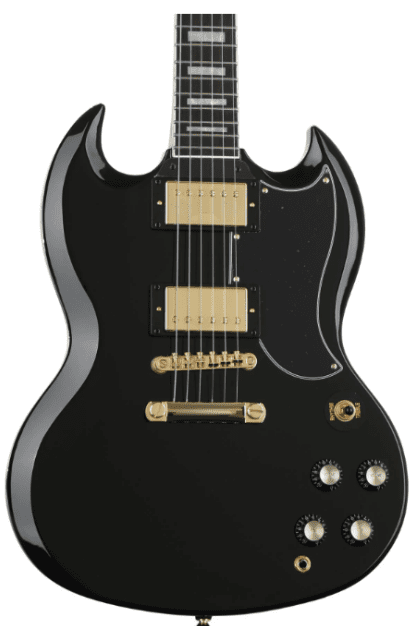
Epiphone SG Custom
Timeless ‘60s hard rock styling with epic tones.
With this SG you’re getting a flagship model for far less than you’d imagine. To hold, and play, you’d be hard pressed to tell anybody it wasn’t a Gibson. It delivers all of the comfort and playability that SGs are famous for, and thanks to the high quality appointments, it looks simply fantastic.
This Epiphone SG Custom was hands down one of the most playable guitars in the round up. As with many of today’s high end Epiphones, it could be considered a true tool guitar for a pro musician, but it’s offered at an attainable price for the average amateur.
Like all proper SGs, it was made with a full mahogany body, but despite the use of a dense wood like this, it was still lightweight and comfortable thanks to the slim dimensions. Our test guitar was finished in Ebony, which always looks brilliant on this model.
It had a set mahogany neck carved into a SlimTaper D profile, which is one of the most comfortable neck shapes around. It was great for fast play, and it still kept our hands feeling full enough to avoid fatigue after extended play.
Being a custom model, it came with a stunning ebony fretboard. It felt incredible, and paired with the off white neck binding it looked brilliant. The edges were smooth, and the crowns were perfectly leveled and nicely polished. Without being PLEKd, this is about as good as frets get.
The Alnico Pro humbucking pickups it came with were extremely lively. They gave us fantastic hard rock tones, and even handled country well, although we did find it difficult to keep the cleans clear in the neck position.
It had gold hardware, which always looks great on black SGs, but we were a little disappointed by the plastic tuning keys, as we’d expected this Custom model to have the Grover Rotomatics. The Epiphone Deluxe tuners performed well and did a great job keeping pitch, but the aesthetics weren’t quite right.
Verdict: The Epiphone SG Custom is a real jack of all trades guitar. It can play just about any style, and it looks great while doing so. The Alnico Pro pickups sounded great, and we found that the overall fit and finish was indicative of a much more expensive model.
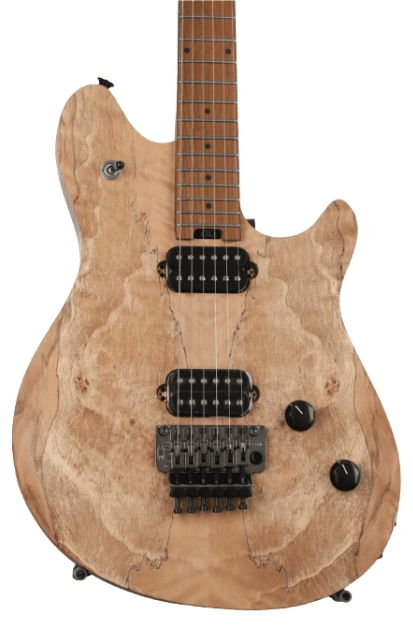
EVH Wolfgang Standard Exotic
Massive tone, superb feel and playability, and boutique guitar looks.
This is yet another smash hit from EVH Guitars. It’s light weight, incredibly playable, and is equipped for serious shredding. You get a Floyd Rose bridge, direct mount humbuckers, high end tuners, and one of the best necks you’ll ever play.
The EVH Wolfgang Standard Exotic was another favorite for the KGR team during this roundup. It was definitely one of the most unique looking guitars we covered, and for fans of rock and metal, this guitar could definitely become your new favorite.
It had a basswood body, which is not uncommon for an import guitar, but what was most unique about the body was the amazing spalted maple top. It had a bookmatched finish, and it looked even better in person than it did in the pictures.
The neck was a bolt on made from baked maple, which gave it tons of snap, and it looked great against the spalted body. It was the neck that really showed off the Wolfgang Standard as a player’s guitar, especially because of the compound radius, which was 12” at the nut, and an ultra flat 16” down at the upper frets. It felt great for lead work, but it had the tendency to induce finger fatigue for rhythm playing due to the lack of curvature.
Not all Floyd Rose Bridges are made equal, but we can happily report that the bridge on this EVH was rock solid. We got some fantastic dive bombs out of it, and even with extreme use, tuning stability was faultless. If you’re a heavy trem user, you’ll probably love this guitar.
Its pickups were simple yet effective. There was no trick wiring, or push pull coil splitting, but what it did have was a pair of quality EVH humbuckers that worked hard no matter how much we pushed them. Clean tones were good, but where this guitar really shone, as you’d expect, was with the gain totally dimed. With the “Brown” setting selected on the Katana, we got searing, squealing crunch that came incredibly close to Eddie’s own infamous Brown sound.
Verdict: The EVH Wolfgang Standard Exotic is a fantastic guitar, but it’s one that is definitely better suited to lead players than it is for rhythm. The build quality was great, and the styling, especially the gorgeous spalted top, really stood out. Tuning stability was perfect, mostly thanks to the locking nut and bridge, and the body contouring made it incredibly comfortable to hold and play whether standing or seated.
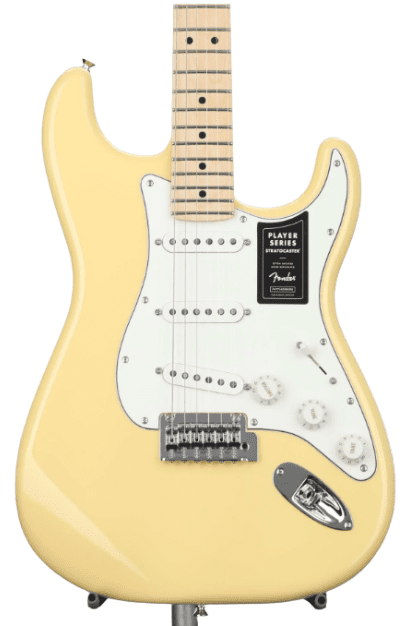
Fender Player Stratocaster
A solid and reliable Strat perfect for players of all abilities.
If you’re in need of a dependable guitar that offers a broad range of great tones, and is built to last, then this Fender Strat should absolutely fit the bill. It’s a no frills approach to what is arguably Fender’s most iconic model, but it’s extremely well executed and it delivers big on all fronts.
The Fender Player Series Stratocaster is the most affordable member of the Fender Stratocaster family, but don’t let that fool you – it’s as well made as models twice its price.
We received a 3 tone sunburst model for our test. This is one of the most iconic colors for a Strat, but it does come in a wide range of other finishes if you’re not into the classics. As with most Fender models now, it had an alder body, which kept the weight down, and simultaneously kept the response bright and snappy.
The neck was maple and had the ever popular Modern C profile. It was incredibly comfortable, and thanks to the shape and the fantastic satin finish, it delivered effortless playability. We found that it encouraged proper form, and was well suited to players of all sizes, with both big hands and small.
Our test guitar had a maple fretboard, but if you prefer a darker look, it’s also available with pau ferro. The fretwork was very nicely finished – there was no sprout on the fret edges, and the corners were perfectly beveled.
For pickups, it was loaded with a traditional 3 x single coil setup. The pickups themselves were exceptional considering that this is an entry level model; they had Alnico V magnets, which delivered beautifully clear tones in all 5 positions. The neck was full and warm, the bridge was sharp and throaty, and the 2 and 4 positions gave us the kind of quack that really draws players to Strats.
The build quality was excellent, and we’ve no doubt that this will be a reliable guitar for working musicians looking for a workhorse instrument. It was fitted with quality hardware, including Fender die cast sealed gear tuners, and a fantastic 2 point trem system.
While we did enjoy playing this Strat, we did find the action to be a little high out of the box. This is of course an easy fix with a setup, but not everybody is able to perform this on their own, and with a good luthier performing a full setup, you’re going to be over the $1k mark.
Verdict: We were big fans of the Fender Player Stratocaster. The neck was a real highlight, and the range of tones we got were beyond expectations at the price. It was built to a high standard at Fender’s Ensenada plant, and will serve you well for many years should you choose to invest in your own.
How To Choose The Right Guitar For You
With a budget of up to $1000, there are tons of options and features available to you, giving you a massive range of guitars to consider. In the below buyer’s guide, we’ve broken down some of the main areas to look for when shopping for your electric guitar.
Pickups
Humbuckers
Guitars with humbucking pickups are widely used in heavier styles of music. Their double coil design cancels out hum when using high gain settings, allowing you to retain clarity when playing with heavy distortion. As well as heavier styles, humbuckers also deliver thick, rich tones when played clean, too.
Single Coil
Single coil pickups are best known for their clear, bright sound. They have a much more treble focused tone than humbuckers, which makes them a great choice for lead guitarists looking to cut through a mix. The downside to single coils is the 60 cycle hum sound they produce due to electrical interference.
P-90
P-90 pickups are also single coil, but as they are made with a wider bobbin than standard single coils, they are noticeably hotter sounding, resulting in a tone that sits somewhere between single coil and humbucker. They’re known for their trademark “growl”, and have increased resistance to the unwanted hum, but not quite to the same level as a humbucker.
Wood
The wood a guitar is made from can have a big impact on the overall tone. Different woods have different densities, and will have unique reactions to string vibrations.
Alder is a common wood, used on many models from Squier and Fender. Its light in weight, making it a comfortable choice, and it has a well balanced tone, with no particular frequency bias.
Basswood is affordable, and easily accessible in Asia, making it popular on imported models. Like alder, it’s light, but it’s a little less balanced, with a more pronounced mid range punch.
Mahogany is a dense, heavy wood, and it gives a guitar an extremely warm tone, with excellent resonance and sustain.
Maple is one of the heaviest woods used in guitar construction. It is often figured and looks incredible as a top. Tonally it is very snappy and extremely bright.
Final Thoughts
With a budget of $1000 you really have a fantastic range of guitars to choose from. In this territory you’re getting into the low end of professional grade, so whether you’re taking your first steps into gigging, or you’ve been playing and recording for some time, and you’re looking to increase your collection, there are tons of choices.
To recap, our top pick was the PRS SE 245 Standard. It’s a modern guitar with versatile tones and great build quality. Our Best value choice was the Squier 40th Anniversary Gold Edition Telecaster. It may not have the Fender branding, but rest assured, it’s just as reliable, and sounds fantastic. Our Editor’s Choice was the Epiphone Les Paul Slash Standard; it’s one of the best looking Epiphones ever made, it offers superb playability, and as far as build quality goes it’s rock solid.


